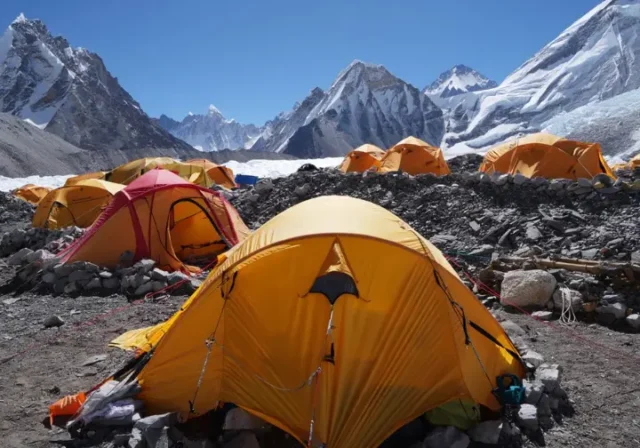In this article
Welcome to the edge of the mountain world, a place few experience firsthand. We’re journeying to Camp 4 on Mount Everest, the final stop before the summit. Here, we’ll explore its precise location, the brutal conditions that define the infamous “Death Zone,” the physiological toll it takes, the critical logistics involved, the extreme dangers climbers face, and the environmental footprint left behind.
This isn’t just about mountaineering; it’s about pushing human limits in one of Earth’s most unforgiving environments. We’ll delve into what it truly means to exist, even briefly, at nearly 8,000 meters. Understanding the essential prerequisites for climbing Mount Everest is the first step. Ready to understand life at the top of the world? Let’s begin the climb.
Pinpointing Camp 4 Everest
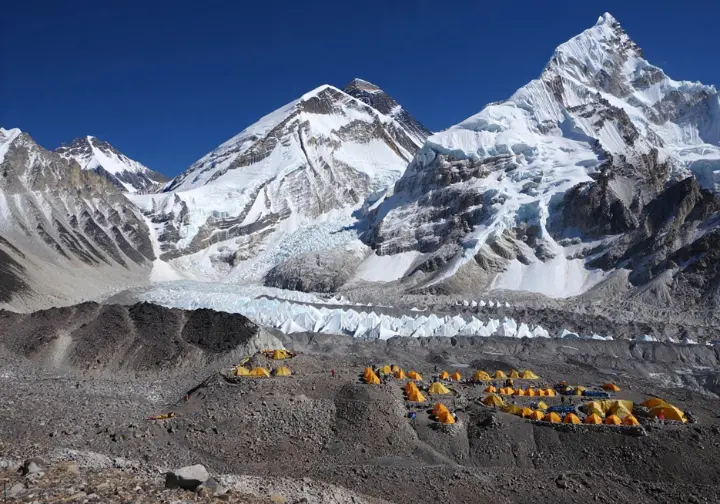
Understanding Camp 4 begins with knowing its exact place on the mountain. This section maps out its location on the South Col, clarifies its critical altitude within the Death Zone, and explains why it’s the essential launchpad for reaching the summit of Everest from Nepal.
South Col Geography Explained
Camp 4 Mount Everest rests on the distinct geographical feature known as the South Col, a wide, high-altitude saddle between Mount Everest (8,848.86m) and Lhotse (8,516m), the world’s first and fourth-highest mountains. This positions it on the border separating Nepal’s Khumbu region from Tibet. The Col itself is a relatively flat but intensely exposed and windswept plateau.
Its coordinates are roughly 27°58’30″N latitude and 86°55’55.5″E longitude. Strong winds constantly scour the area, preventing deep snow buildup and leaving mostly rock and ice. This exposure is a major factor in the harsh conditions faced by mountaineers at this camp.
The geography dictates approach routes and challenges. As a natural convergence on the Southeast Ridge route, it’s the logical, though perilous, spot for the final camp. Its location between two massive peaks also channels fierce winds across the plateau, impacting local weather.
The ground underfoot isn’t deep snow but exposed rock and ice, demanding secure anchoring for tents and careful movement. This lack of snow cover also means less insulation from the biting ground cold, adding to the physical stress for any climber.
Being on the Nepal-China border adds complexity, though climbs using the South Col route originate from the Nepalese side. Nepalese authorities manage permits and regulations for this approach to Mount Everest is Earth’s highest mountain.
Defining Critical Altitude
Camp 4’s elevation sits critically near 8,000 meters, placing it firmly in the “Death Zone.” Figures vary slightly, often between 7,906m (25,938 ft) and 8,016m (26,300 ft), generally settling around 7,950 meters (roughly 26,000 feet). This altitude is physiologically extreme for humans.
The significance is profound: above 8,000 meters, the human body cannot acclimatize to the low oxygen. Instead, it steadily deteriorates. Time spent at Camp 4, on the South Col at nearly 8,000m, becomes a race against physical decline, a core challenge of any Mount Everest expedition.
Atmospheric pressure here is less than 356 millibars (vs. 1013 at sea level). While oxygen percentage is ~21%, the low pressure drastically cuts the available oxygen molecules per breath – roughly one-third of sea level. This severe hypoxia is the defining characteristic of the Death zone.
Minor variations in reported elevation (7,906m, 7,950m, etc.) don’t alter the reality: it’s a hostile environment. Even with supplemental oxygen, the body struggles. Understanding this context, often visualized on Mt. Everest South Col Route Maps, reveals the inherent risks faced by experienced climbers and novices alike.
This critical altitude drives extreme physiological challenges: severe breathlessness, rapid heart rate, heightened risk of HAPE/HACE, and significant cognitive impairment. Minimizing time here is a fundamental survival tactic; the body simply cannot sustain itself for long.
Strategic Summit Staging
For climbers on the standard Southeast Ridge route from Nepal, Camp 4 is the non-negotiable final staging post before the summit attempt. It’s the culmination of weeks spent ascending through lower camps, providing the launchpad for the final push toward the peak.
Arriving from Camp III on the Lhotse Face, climbers undertake final preparations: checking gear, forcing hydration and calories, and attempting brief rest, usually on supplemental oxygen. The goal is readiness for a weather window allowing a safe ascent.
Its strategic value lies in proximity to the summit, enabling a shorter final push than from lower camps. This benefit comes at the cost of being deep in the Death Zone, demanding minimal time spent – often just hours – before starting the climb, typically late at night. Knowing the number of camps on Mt Everest helps understand this progression.
Reaching Camp 4 carries immense psychological weight. It marks commitment to the summit bid, where abstract dangers become immediate realities. Fatigue mixes with the daunting view of the final pyramid ahead, adding a significant mental burden to the adventure. Have you ever faced a moment where commitment felt absolute?
Logistics here are entirely focused on the summit push. Sherpas are vital, establishing the camp, stocking oxygen, fuel, and food. Their work allows climbers to conserve energy, directly impacting safety and success chances based on the Mount Everest Expedition climbing strategy.
Extreme Death Zone Conditions

Life at Camp 4 is defined by the brutal environmental realities of the Death Zone. This section explores the severe hypoxia resulting from low atmospheric pressure, alongside the relentless threats of extreme cold, hurricane-force winds, and unpredictable storms that challenge every expedition.
Defining Altitude and Oxygen
The “Death Zone,” altitudes above 8,000 meters (26,247 feet), signifies where air pressure is too low for long-term human survival without supplemental oxygen. Camp 4 sits squarely at this threshold. Severe hypoxia is the dominant environmental challenge, impacting every bodily function.
It’s not the percentage of oxygen (~21%) that changes, but the drastically lower barometric pressure (below 356 millibars). This reduces the partial pressure of oxygen (PO2), meaning far fewer oxygen molecules reach the lungs with each breath. This is why the zone is inherently dangerous for mountaineers.
The human body cannot acclimatize here. Unlike lower mountains, prolonged exposure above 8,000 meters leads inevitably to physiological breakdown and cellular damage. Learning how the body copes above 8,000 meters reveals this reality dictates the strategy: minimize time spent at Camp 4 to survive the whole climb.
Even with supplemental oxygen, the feeling of altitude is intense. Climbers battle extreme breathlessness, fatigue, and cognitive issues. Oxygen helps but doesn’t negate the fundamental challenge of functioning in an oxygen-starved environment during a Mount Everest expedition. Using oxygen at altitude is a complex decision.
This profound lack of oxygen is the root cause of deadly conditions like High Altitude Pulmonary Edema (HAPE) and High Altitude Cerebral Edema (HACE). Low PO2 triggers fluid buildup in the lungs or brain, making awareness of symptoms critical, as explained in discussions of Mount Everest’s Death Zone: What Happens to the Human Body.
Brutal Weather Patterns
Extreme cold is unrelenting at Camp 4. Temperatures during summit pushes, often at night, typically range from -20°C to -40°C (-4°F to -40°F). Daytime remains frigid. Storms can bring even colder conditions, demanding specialized gear like the best ice climbing jacket and multi-layered systems.
The South Col is notoriously windswept, with frequent winds of 50-100 km/h (30-60 mph). Proximity to the jet stream means winds can escalate suddenly to over 150-200 km/h (93-124 mph). Such force poses a direct physical threat and drastically increases wind chill, a major concern for any expedition leader.
Sudden storms engulfing the upper mountain bring zero visibility (whiteouts) and lethal conditions. Trapped climbers face disorientation, exposure, frostbite, and hypothermia, a situation described vividly in accounts like “A Time To Live, A Time To Die, Tragedy on the Southeast Ridge”. The 1996 disaster serves as a stark reminder of how rapid weather changes are a primary objective hazard during the climb.
The combination of cold and wind (wind chill) accelerates body heat loss dramatically. This magnifies the risk of frostbite on extremities (fingers, toes, nose) and hypothermia. Protecting against wind chill is as vital as insulating against ambient cold for climbers aiming for the summit, one of the key dangers facing Mt. Everest climbers.
While the Col is often rocky/icy, routes above involve steep snow and ice. Conditions change rapidly with weather, affecting safety and speed. The thin atmosphere and reflective snow also mean high UV radiation, requiring constant eye and skin protection. This is a key part of mountaineering safety within the Death Zone on Everest.
Compounding Environmental Dangers
The hazards at Camp 4 don’t exist in isolation; they interact and amplify each other. Extreme cold becomes far deadlier with high winds (wind chill). Simultaneously, hypoxia impairs the body’s heat generation, increasing vulnerability. This synergy makes survival on Everest uniquely challenging.
Hypoxia impairs judgment and slows reactions, hindering responses to sudden weather shifts or gear problems. An oxygen-starved brain makes critical errors more likely when assessing risk or performing safety procedures. This cognitive decline contributes significantly to accidents near the summit.
Storms bring a lethal mix: high winds, driving snow, extreme cold, and zero visibility. Climbers can become lost meters from their tents. Winds can damage or destroy shelters, leaving occupants exposed—an apocalyptic sight described by survivors of events like the Everest Winter Ascent and Tragedy.
Basic survival tasks like melting snow or preparing food become monumental efforts due to cold, wind, and hypoxia-induced fatigue. This often leads to dehydration and poor energy intake, weakening the climber and increasing susceptibility to cold injuries and exhaustion, a struggle detailed in narratives of summit night climbing Mount Everest.
The cumulative effect leaves almost no margin for error. A small mistake, a minor delay, or slightly worsening conditions can rapidly cascade into a life-threatening situation. This unforgiving environment demands constant vigilance and conservative decisions from all mountaineers.
Physiological Toll Above 8000m
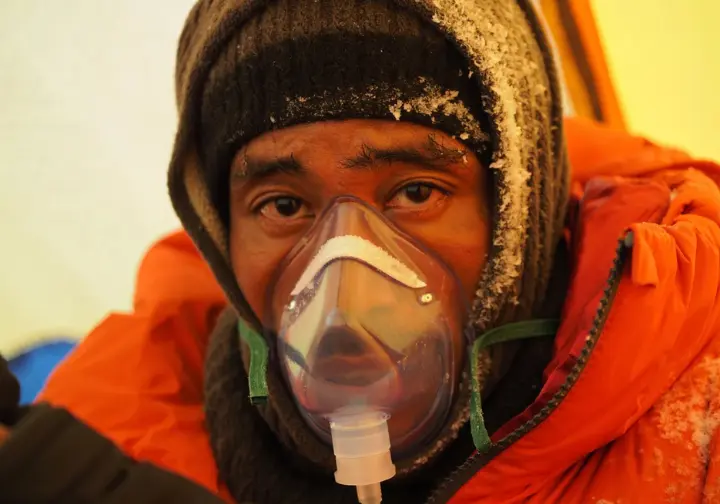
Existing at Camp 4 exacts a devastating price on the human body. This section details the impact of severe hypoxia, the life-threatening risks of HAPE and HACE, the physical damage from cold and dehydration, and the profound cognitive impairment experienced near the summit of Mount Everest.
Hypoxia’s Suffocating Grip
Severe hypoxia dominates physiology at Camp 4. With roughly one-third of sea-level oxygen, basic functions strain immensely. Climbers experience extreme shortness of breath even at rest; physical exertion becomes incredibly taxing. Every movement feels like wading through thick treacle.
The heart works furiously to compensate. Heart rate often exceeds 100 bpm even while resting inside tents. Breathing is deep and rapid as lungs struggle to extract oxygen from the thin air. It’s a constant battle for every molecule of oxygen.
Physical performance plummets. Muscles fatigue quickly, endurance vanishes, and movement slows dramatically. Each step demands conscious effort and specific breathing techniques. We’ve seen experienced climbers reduced to taking several breaths per step on steep sections.
Cyanosis – a bluish tint to skin, lips, and nail beds – can appear due to deoxygenated blood. It’s a visible sign of the body’s desperate struggle for oxygen, highlighting the severity of the hypoxic stress faced during the ascent.
This oxygen starvation impacts every organ, but the brain and lungs are most vulnerable. It directly increases HACE and HAPE risks while impairing coordination and thought processes. Understanding hypoxia is key to grasping all physiological dangers at this altitude.
Risk of HAPE and HACE
High Altitude Pulmonary Edema (HAPE) is a critical danger. Fluid leaks into the lungs’ air sacs, blocking oxygen transfer. Symptoms include extreme breathlessness, a persistent cough (often with frothy/pink sputum), and chest gurgling. Untreated, it leads rapidly to respiratory failure and death.
High Altitude Cerebral Edema (HACE) involves brain swelling due to fluid leakage. Symptoms progress from severe headache and nausea to confusion, loss of coordination (ataxia – appearing drunk), poor judgment, and potentially coma. HACE impairs decision-making, leading to fatal errors during the climb.
Both HAPE and HACE demand immediate, rapid descent as the primary treatment. However, initiating descent from Camp 4 or higher is often incredibly difficult due to terrain, weather, darkness, or the patient’s state. This makes these conditions exceptionally deadly at extreme elevation.
The impaired judgment from HACE is particularly insidious. Sufferers may not recognize their symptoms, resist help, or make irrational choices like removing clothing. This underscores the importance of climbing with vigilant partners who can spot these warning signs on a Mount Everest expedition.
While supplemental oxygen helps manage symptoms, it doesn’t cure established HAPE or HACE. Descent remains the only definitive treatment. The risk underscores the peril of lingering too long in the Death Zone near the Utopia Summit.
Physical Damage Breakdown
Frostbite is a major threat due to extreme cold and wind, worsened by hypoxia impairing circulation. Fingers, toes, nose, and ears are most vulnerable. Tissue death can lead to permanent damage and amputation. Many Everest survivors bear these scars, a grim reality discussed in articles about the Death Zone on Everest.
Hypothermia, a dangerous drop in core body temperature, is another significant risk. It impairs physical and mental function, causing shivering (which may cease), slurred speech, confusion, and drowsiness. Severe hypothermia is fatal, heightened by exhaustion and inadequate wind protection, contributing to the number of Everest dead bodies.
Dehydration is relentless at high altitude. Fluid loss increases through breathing dry air (causing the “Khumbu cough”) and exertion. Melting snow for water is laborious and fuel-intensive. Dehydration worsens fatigue, increases cold injury risk, and thickens blood, raising clot chances.
Profound exhaustion is inevitable by Camp 4, stemming from weeks of climbing, acclimatization stress, poor sleep, and the effort of existing at altitude. This deep fatigue impairs performance, slows movement, and contributes significantly to accidents, especially during descent.
The digestive system functions poorly, causing appetite loss and nausea. Climbers must force down high-energy foods despite this. Inadequate nutrition compounds exhaustion and weakens the body’s ability to cope with cold and stress, making the final push towards the summit even harder.
Cognitive Impairment Effects
Hypoxia severely impacts brain function, causing cognitive impairment often likened to severe intoxication. Judgment and decision-making deteriorate, increasing the risk of critical errors in navigation, gear use, or risk assessment. This mental fog is a significant hidden danger for every climber.
Confusion and disorientation are common. Climbers might become unsure of their location, the route, time, or even companions’ identities. This can lead to fatal navigational mistakes, particularly in poor visibility or darkness during the ascent or descent.
Short-term memory issues make recalling instructions or recent actions difficult, like checking oxygen levels. Simple tasks become complex mental challenges. We’ve heard stories of mountaineers forgetting basic safety checks due to the altitude’s effects.
The immense psychological stress – constant danger awareness, physical discomfort, isolation, pressure – compounds cognitive issues. Fear and anxiety, though actively managed, can become overwhelming under hypoxic conditions, affecting even the most experienced climbers.
Hallucinations can occur, triggered by HACE, extreme fatigue, or severe hypoxia. These range from minor disturbances to complex, disorienting experiences, further impairing a climber’s grasp on reality. Recognizing this potential decline is vital for team safety on Everest.
Logistics at Camp 4
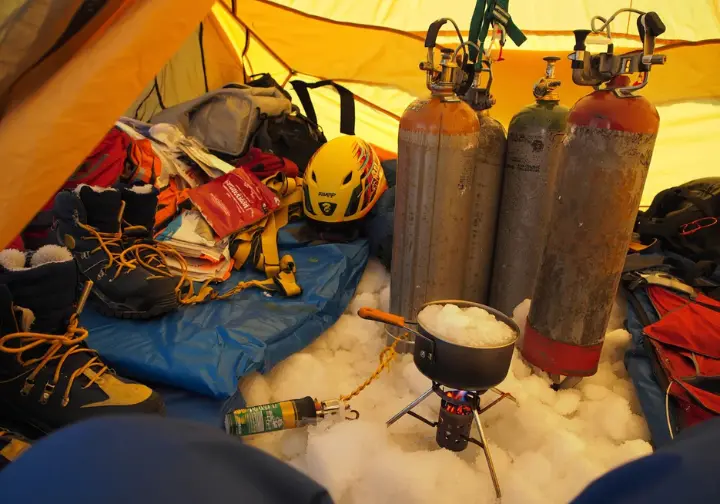
Surviving at Camp 4 requires navigating immense logistical hurdles. This section covers the temporary nature of shelter, the critical time limits imposed by physiology, the lifeline (and risks) of supplemental oxygen, the struggle for basic survival needs, and the meticulous preparations for the summit attempt.
Temporary Tent Shelters
Camp 4 isn’t permanent; it’s a shifting collection of specialized high-altitude tents pitched on the South Col’s exposed, windswept rock and ice. These tents offer the only refuge but provide minimal comfort or insulation against the extreme cold. The camp’s layout changes each expedition season.
These expedition tents are built for high winds but remain vulnerable. Accounts abound of tents being damaged, shredded, or blown away, sometimes with dire consequences. Securely anchoring new tents upon arrival is a critical, energy-sapping task for climbers and Sherpas, especially when Everest Camp 4 is swamped with trash and old debris.
The South Col’s relatively flat expanse allows multiple teams to set up their Camp 4 sites near each other, creating a temporary “village” during peak season. However, this concentration also contributes to waste accumulation, an ongoing issue on Mount Everest.
Inside the tents, conditions are harsh. Frost coats inner walls, space is cramped with bulky gear. Simple actions like changing clothes, organizing equipment, or melting snow become difficult maneuvers. It’s a far cry from the relative comfort of Base Camp.
A tent’s integrity is paramount. Damage offers little protection from lethal wind chill. Ensuring the tent is properly erected, anchored, and maintained is a key logistical priority upon reaching this final camp before the summit push, avoiding potential Everest tragedy scenarios.
Critical Time Constraints
Minimalism governs time spent at Camp 4. Acclimatization is impossible above 8,000 meters; physiological deterioration is constant. Climbers aim for the shortest possible duration before launching their summit bid or descending. Delay drastically increases risk.
A typical pre-summit stay is brief, often around 10 hours or less. This allows just enough time for essentials: attempting rest, hydrating, consuming calories, final gear prep before departing late at night. Prolonged stays invite disaster for any Mount Everest expedition.
Safety guidelines suggest an absolute maximum stay in the Death Zone (Camp 4 and above) shouldn’t exceed 16-20 hours, though some push towards 48 hours. Exceeding these rough limits correlates strongly with increased rates of severe altitude sickness, frostbite, exhaustion, and fatalities.
Summit attempts hinge entirely on favorable weather windows – periods of low wind and clear skies, a crucial factor discussed when considering the best time to climb Everest. Climbers reaching Camp 4 usually have only a narrow 2-3 day window to wait before their physical state degrades too much for a safe attempt. What choices would you make facing such a deadline?
If weather doesn’t cooperate within this critical timeframe, climbers usually must descend, often back to Base Camp or Camp II, to recover. Attempting a summit push in poor weather or after prolonged exposure at Camp 4 significantly heightens danger. The clock never stops ticking here.
Supplemental Oxygen Lifeline
For most modern Everest climbers (clients and Sherpas), supplemental oxygen (O2) is essential for survival and function at Camp 4 and during the summit push. It mitigates severe hypoxia effects but doesn’t eliminate danger. Climbing without O2 (a no-O2 climber) is exceptionally rare and riskier.
Systems typically involve lightweight cylinders, a regulator for flow rate, and a mask. Oxygen is used while resting/sleeping at Camp 4 and continuously during the ascent to and descent from the summit. Correct system management is a critical skill learned during mountaineering training, often requiring specific climbing gear for mountains.
Flow rates are carefully managed (e.g., 2 liters per minute rising to 4 lpm or higher for the push). Higher flow provides more benefit but consumes O2 faster, demanding meticulous planning of bottle changes by the climber or Sherpa team.
While O2 improves breathing and aids rest, it’s not a magic bullet. It primarily keeps climbers alive and functioning, not restoring sea-level performance. Significant impairment remains even with oxygen, a reality faced by every specific expedition.
Reliance on O2 introduces new risks: equipment malfunction (frozen regulators, leaks), depletion (running out due to delays, miscalculation), and the challenge of carrying/changing heavy bottles. System failure high on the mountain is a critical emergency.
Basic Survival Challenges
Eating and drinking become major hurdles at Camp 4. Altitude suppresses appetite and causes nausea; digestion slows. Climbers must force down high-energy foods (gels, bars) and liquids despite lacking hunger or thirst, crucial for maintaining energy for the whole climb.
Generating water means melting snow/ice with stoves inside tents – slow, laborious, and fuel-intensive. Fuel is another critical resource managed carefully. Dehydration severely increases risks, making this difficult task vital for survival before the summit attempt.
Rest and sleep are elusive. Hypoxic stress, intense cold, discomfort, anxiety, and the encumbrance of an oxygen mask make quality sleep nearly impossible. Climbers typically manage only short periods of fitful dozing before their final ascent.
Every simple action – putting on boots, adjusting layers, operating a stove – requires far more time and effort due to cold, bulky clothing, and hypoxia. Tasks need methodical execution to avoid errors. Fatigue makes basic self-care a struggle for even experienced climbers.
Waste management, especially human waste, is tough. Historically left on ice, regulations now mandate “poop bags” that climbers must pack out. This adds another logistical burden to the already difficult task of survival at extreme altitude on Mount Everest.
Summit Push Preparations
The brief stay at Camp 4 is intensely focused on final summit push preparations. This involves meticulous gear checks: headlamps (fresh batteries), oxygen system (mask fit, cylinder pressure), crampons, ice axe, summit pack contents, clothing layers. Redundancy is key, as described by those at Camp 4 and getting ready for our summit attempt.
Drying damp boot liners and gloves is critical to prevent frostbite during the long, cold ascent. Climbers often keep liners inside sleeping bags or down suits. Wet gear at this altitude quickly leads to severe cold injuries, potentially ending summit bids.
Mental preparation is vital. Climbers manage anxiety, maintain focus, visualize the route and challenges, commit to the plan, yet remain ready to turn back if needed. The psychological pressure before leaving the final camp is immense. Could you maintain focus under such conditions?
Departures are typically timed for late evening or around midnight (8 PM – 12 AM). This allows ascending through the coldest night hours but reaching the summit in morning light, maximizing daylight for the perilous descent. Timing is critical for safety.
The entire summit push from Camp 4 is a grueling 12-20+ hour round trip endurance test. It pushes climbers to their absolute physical and mental limits, demanding careful pacing, energy management, hydration, and constant self-monitoring under extreme duress.
Navigating Extreme Dangers
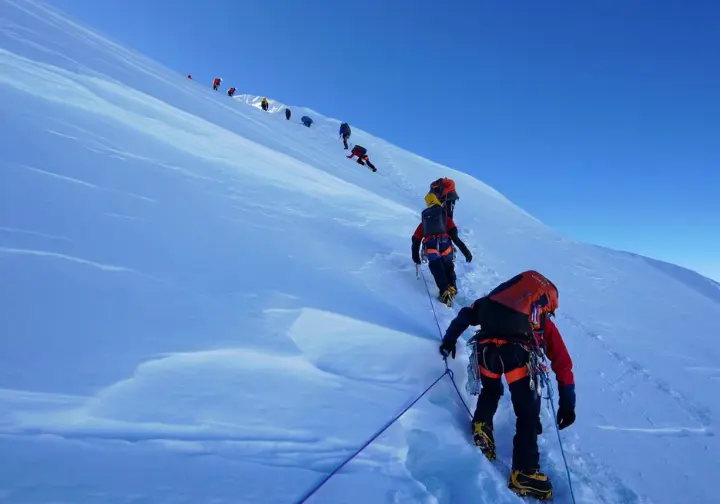
The journey from Camp 4 to the summit and back traverses a landscape fraught with lethal risks. This section outlines the primary objective hazards, the insidious dangers of altitude sickness, the particular perils of the descent, the stark limitations of rescue, and the added hazards of overcrowding.
Primary Objective Hazards
Falls are a major killer on Everest, especially on exposed terrain above Camp 4. The route includes steep snow/ice, rocky sections, and the exposed summit ridge (Cornice Traverse, Hillary Step area). A slip here means potentially thousands of meters of exposure. Fixed ropes offer security but aren’t foolproof.
Profound exhaustion, particularly during descent, dramatically increases accident risk. Tired climbers move slowly, make mistakes, and may lack strength for safe down-climbing. Collapse leaves them vulnerable to exposure, a common scenario in mountaineering tragedies.
Exposure to extreme cold and wind is constant, rapidly causing hypothermia and frostbite if climbers are delayed, lost, or caught in storms. An unexpected bivouac high on the mountain is often fatal. The cold-wind-hypoxia combination is lethal.
Malfunction or depletion of supplemental oxygen is critical. Frozen regulators, leaking masks, or running out of O2 can quickly incapacitate a climber, leading to collapse and death. Diligent management and backup plans are essential for any expedition.
Objective hazards like avalanches and serac (ice cliff) collapses pose significant threats, especially on the Lhotse Face below Camp 4 and potentially higher up. Understanding how dangerous is climbing Mount Everest involves recognizing these risks, tragically demonstrated in incidents like the 2014 Khumbu Icefall disaster.
Altitude Sickness Dangers
Severe altitude sickness (AMS, HAPE, HACE) onset or worsening in the Death Zone is extremely dangerous. The primary treatment – immediate descent – is often impossible or too slow. Symptoms progress rapidly at this extreme altitude. Developing HAPE/HACE at or above Camp 4 is frequently fatal.
Altitude-related illnesses contribute significantly to the Everest death toll. This includes HAPE/HACE and other medical events like strokes or heart attacks triggered by severe hypoxia, dehydration, and blood thickening. Understanding the deadly geography of Mount Everest highlights these patterns.
Cognitive impairment from hypoxia/HACE can prevent climbers from recognizing symptoms or making rational descent decisions. They might insist they’re fine, delaying life-saving actions. Close monitoring by team members is crucial, a key responsibility for any expedition leader.
Even climbers using supplemental oxygen aren’t immune. Exertion, physiology, hydration, and ascent rate still matter. Oxygen system failure can also trigger rapid onset of severe symptoms, catching even experienced climbers off guard.
Difficult diagnosis and treatment at extreme altitude make these conditions perilous. Differentiating exhaustion, hypothermia, and altitude sickness is challenging. Effective medical intervention beyond basic first aid and oxygen is usually impossible without descent.
The Treacherous Descent Phase
Statistically, descending from Everest’s summit is more dangerous than the ascent. A higher proportion of fatalities occur during this phase. Climbers are maximally exhausted, oxygen may be low, and concentration often fades after reaching the goal. Focus must remain on safe return, a point emphasized when comparing the routes of Everest.
Descent dangers include extreme fatigue, depleted oxygen, weather deteriorating later in the day, and the technical difficulty of down-climbing steep terrain when exhausted. Judgment or technique errors are more likely. Many tragedies unfold after the summit has been climbed.
The psychological letdown after summiting (“summit fever” breaking) can cause a dangerous vigilance lapse. Climbers might underestimate remaining hazards or push too hard ascending, leaving insufficient reserves. Maintaining focus until safely back at Camp 4 or lower is critical.
Navigational errors increase during descent, especially in poor visibility or darkness. Finding the correct route down and locating fixed ropes requires attention, difficult when exhausted and cognitively impaired. Getting lost on descent from the peak is often fatal.
Many incidents involve climbers collapsing from exhaustion or succumbing to altitude sickness on descent, unable to continue. The difficulty of rescue means such situations often end tragically. The mantra “Getting to the top is optional, getting down is mandatory” highlights this critical phase.
Rescue Limitations Above 8000m
Effective rescue from Camp 4 or higher is exceptionally difficult, often impossible, magnifying the consequences of any accident or illness. Helicopter evacuation, common lower down, is generally unfeasible at this altitude due to thin air, extreme weather, lack of landing sites, and pilot limits. The question ‘Can A Helicopter Fly To The Top Of Mount Everest‘ highlights these challenges.
Rare, specialized long-line helicopter rescues have occurred up to ~7,800m in perfect conditions, but these aren’t standard. Routine helicopter Search and Rescue is unavailable at Camp 4’s elevation. Hope for external rescue is slim.
Ground rescues depend almost entirely on fellow climbers and high-altitude Sherpas, operating at their own limits. Such efforts are incredibly slow, arduous, dangerous for rescuers, and resource-intensive (personnel, oxygen). Moving an incapacitated climber down from the Death Zone is monumental.
The difficulty and risk mean seriously ill or injured climbers high on the mountain often cannot be brought down. This grim reality explains why many who perish remain where they fall; recovery poses too great a risk. Self-sufficiency and prevention are paramount.
This lack of effective rescue underscores the commitment made when entering the Death Zone. Climbers rely on strength, preparation, judgment, team support, and luck, knowing help is unlikely if things go wrong. It emphasizes conservative decisions and turning back early, knowing helicopter flights to Everest peak are not standard.
Overcrowding and Bottlenecks
Increasing Everest popularity, particularly via the South Col route from Nepal, leads to significant overcrowding during peak season (July is monsoon, so spring is peak). This creates dangerous “traffic jams” at bottlenecks above Camp 4, like the Balcony, South Summit traverse, and Hillary Step area.
Waiting in line at extreme altitude, often for hours, has severe consequences. Climbers burn limited oxygen while stationary, expend energy in the cold, and increase total time exposed in the Death Zone. These delays, one of the hazards of the South Side of Mount Everest, directly heighten risks for everyone involved in summit bids.
Queue delays can cause climbers to summit dangerously late, forcing descent in darkness or worsening weather. Running out of oxygen during descent due to unexpected queue delays is a major hazard linked to fatalities, tragically highlighted in recent seasons.
Large numbers, potentially including less experienced or slower climbers, exacerbate bottlenecks and increase risk. Managing traffic flow is a critical challenge for expeditions, but control is limited on crowded days, impacting the mountain tourism business.
Overcrowding increases direct risks and contributes to environmental degradation (waste) and strains fixed ropes. It raises complex questions about managing access and capacity on the world’s highest peak, a challenge faced by companies like Madison Mountaineering.
Environmental Impact High Up
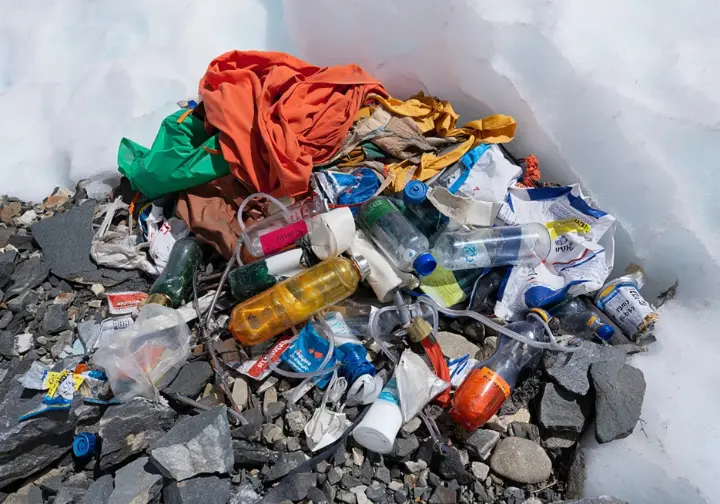
Human presence, even temporary, leaves a mark on Mount Everest. This section examines the environmental footprint at high altitudes, focusing on waste accumulation at Camp 4, human waste challenges, cleanup efforts, and the difficult balance between access and preservation.
Accumulated Waste Issues
Camp 4 and the South Col have unfortunately become known as high-altitude junkyards due to decades of accumulated waste. Debris includes abandoned tents, empty oxygen cylinders, discarded gear, food packaging, fuel canisters, and other trash. The visual impact is stark and widely reported.
The core reason is the extreme difficulty, danger, and cost of carrying waste down from the Death Zone. Exhausted climbers and Sherpas prioritize survival on descent; removing bulky items requires significant extra effort and resources, often deemed too risky or expensive.
Recent reports indicate the problem persists despite cleanups, with some describing Camp 4 as increasingly littered. Abandoned, wind-shredded tents are common, alongside scattered oxygen bottles. The sheer volume of climbers contributes to ongoing waste generation each season.
Expeditions may find abandoning gear like tents cheaper than paying Sherpas high rates for retrieval from such extreme altitudes. This economic factor contributes to larger debris accumulation. Lack of enforcement or practical removal means exacerbates the issue, a sad reality detailed as climbers have turned Mount Everest into a high-altitude garbage dump.
This waste isn’t just unsightly; it pollutes a fragile environment. Concerns exist about plastics, metals, and other materials degrading slowly in the extreme cold, potentially contaminating meltwater flowing down into the valley, a key issue as Mount Everest confronts the perils of pollution.
Human Waste Management Challenges
Managing human excrement at Camp 4 and other high camps is a significant challenge without permanent toilets. Historically, waste was deposited on snow/ice, freezing but remaining a long-term pollutant, leading to contamination concerns over time.
Lower down at Base Camp, systems involve collecting waste in barrels, managed by the Sagarmatha Pollution Control Committee (SPCC). Even these face challenges, with potential leakage from disposal pits near Gorakshep possibly contaminating water sources, especially during monsoons.
A major 2024 regulation mandates using special biodegradable “poop bags” at Base Camp and higher camps, including Camp 4. Climbers must use these and pack waste out, presenting used bags upon return. This directly targets high-altitude human waste pollution, part of efforts tackling Everest’s waste through art and action.
The poop bag rule’s effectiveness hinges on consistent enforcement and compliance – logistically challenging above Base Camp. It adds another task for climbers and Sherpas under duress. Still, it’s a significant step towards mitigating direct pollution at high camps, though some Nepal new rules are seen as mixed.
Melting glaciers due to climate change are exposing waste buried decades ago, highlighting past practices’ long-term consequences and the urgency of effective solutions. This legacy waste adds another layer to the cleanup challenge facing Nepal and the mountaineering community.
Cleanup Efforts Undertaken
The Sagarmatha Pollution Control Committee (SPCC), formed by local Sherpas, is key to waste management in the Everest region. They oversee collection/segregation at Base Camp, manage disposal, monitor regulations, and run awareness programs. Their work is fundamental.
Since 2014, Nepal’s government requires each climber above Base Camp to bring down at least 8 kg of solid waste, enforced via a $4,000 garbage deposit monitored by SPCC. Its effectiveness is debated; some may forfeit the deposit rather than carry trash from extreme altitudes.
Dedicated cleanup expeditions (military, NGOs, operators) periodically remove tons of garbage from Base Camp and higher camps like Camp 4. These efforts are valuable but episodic, struggling to keep pace with new waste generated each climbing season.
Innovative initiatives like Sagarmatha Next’s “Carry Me Back” encourage trekkers/climbers to voluntarily carry down 1kg bags of pre-processed waste to Lukla. Their “Waste to Art” projects also raise awareness by transforming mountain trash into artwork.
A critical development is SPCC’s Material Recovery Facility (MRF) near Namche Bazaar. This facility improves sorting, segregation, and pre-processing (shredding, compressing) of recyclables collected from the region, making transport out of the valley more efficient and economical, as evidenced when SPCC collects 85 tons of waste from EBC in spring 2024.
Balancing Access and Preservation
Everest’s environmental issues highlight a conflict: preserving the fragile ecosystem versus supporting the Khumbu economy, heavily reliant on mountain tourism business. Finding a sustainable balance is crucial but difficult. Regulations aim to mitigate impact, but enforcement remains challenging.
The sheer volume of climbers and trekkers strains waste management infrastructure and contributes to pollution, despite rules like the 8kg requirement and mandatory poop bags. The scale of human activity challenges local organizations like SPCC.
Microplastic pollution, mainly from shedding synthetic clothing/equipment fibers, is a less visible but pervasive impact throughout the region, including high-altitude snow. This shows pollution extends beyond visible trash, requiring different mitigation strategies.
Effective long-term solutions need a multi-faceted approach: stricter enforcement, investment in better infrastructure (like the MRF), continued cleanups, promoting responsible tourism (“leave no trace”), and potentially exploring permit limits. Collaboration is essential, as outlined in plans like A Sustainable Solid Waste Management Plan for Sagarmatha National Park.
The waste at Camp 4 starkly reminds us of human impact on even the most remote environments. Addressing this requires ongoing commitment and innovation, ensuring the pursuit of adventure doesn’t irrevocably damage the places that inspire it. What role should individual climbers play in this?
Frequently Asked Questions
What is the “Death Zone” on Mount Everest? >
How long do climbers typically stay at Camp 4? >
Is rescue possible from Camp 4? >
What happens to trash and waste at Camp 4? >
We are a participant in the Amazon Services LLC Associates Program, an affiliate advertising program designed to provide a means for sites to earn advertising fees by advertising and linking to Amazon.com. As an Amazon Associate I earn from qualifying purchases. We also participate in other affiliate programs. The information provided on this website is provided for entertainment purposes only. We make no representations or warranties of any kind, expressed or implied, about the completeness, accuracy, adequacy, legality, usefulness, reliability, suitability, or availability of the information, or about anything else. Any reliance you place on the information is therefore strictly at your own risk. Additional terms are found in the terms of service.



